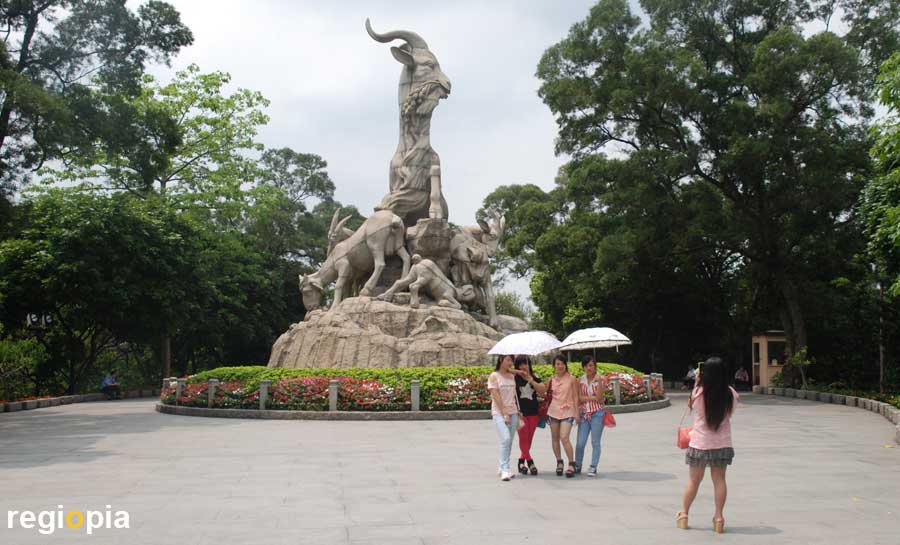
Fife Rams Monument 五羊石雕
Guangzhou or Canton is also known in China as Yang Cheng, the city of goats. According to an ancient legend, the city suffered after a bad harvest of a fatal famine as 5 immortals were approached on goats and threw 5 rice bundles on the land. The immortals promised the people that they would no longer suffer from any famine and left their 5 goats behind in Guangzhou. Out of gratitude for the salvation of their city, the 5 Goat Memorial was built in 1959 in Yuexiu Park. The Five Goat Monument (Wu Yang Shi Diao 五羊 石雕) is the landmark of Guangzhou.
The Yuexiu Gongyuan is quite big, to find the 5 Rams Monument just click on the orange marker below.
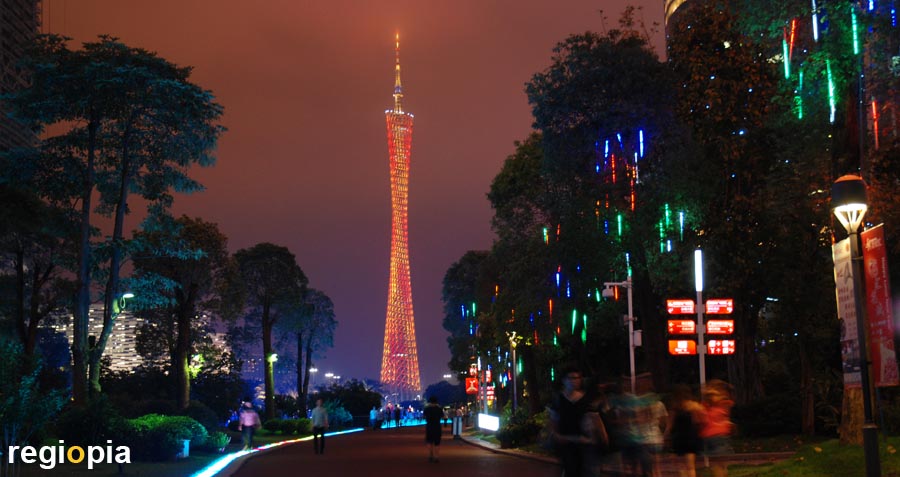
Canton Tower 广州塔
The "Canton Tower" is the highest building in the city at 604 m. From 2009 to 2011 it was even the tallest tower in the world, but counts the Burj Khalifa (828 m / year of construction 2008) as a skyscraper and thus not on the list of the tallest towers. The Canton Tower was officially surpassed by Tokyo Skytree at 634 m. The tower consists of a 462 m high building on which a 142 m high antenna stands. The city of Guangzhou is still called Canton by the English, therefore the Guangzhou ta (chinese name of the tower) is called Canton Tower. The twisted building was designed by the Dutch architects Mark Hemel and Barbara Kuit. In 2010, the Canton Tower was opened. It stands directly on the Pearl River (Zhujiang), opposite the new business center of Guangzhou. Directly at the tower base is a subway station. The tower has viewing platforms at various heights, restaurants, cinemas, function rooms and shops.
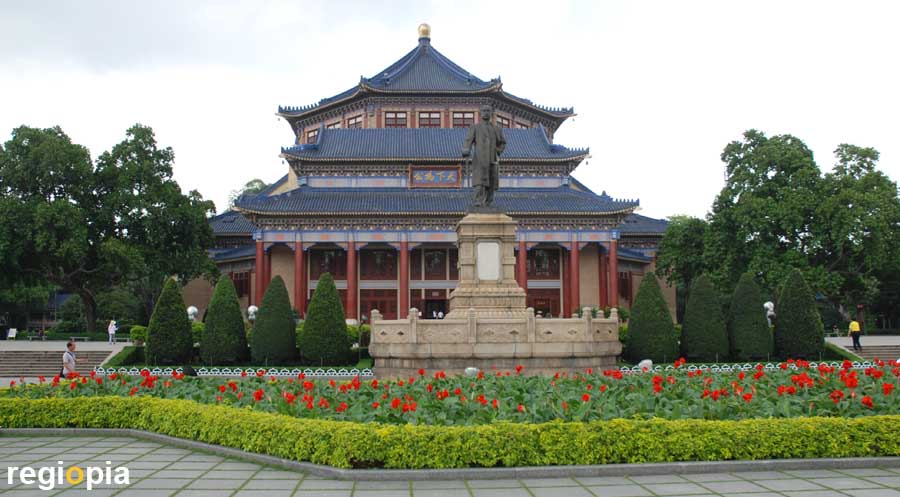
Dr. Sun Yatsen Memorial Hall
Dr. Sun Yatsen (Sun Wen, later Sun Zhongshan) was a Guangdong doctor who founded the 1912 National People's Party Guo Min Dang. In China and Taiwan he is called Sun Zhongshan. He received the name in his Japanese exile, where he was called Sho Nakayama. Sun Yatsen became the first president of China after the emperor had to abdicate in 1912. In 1913, Sun Yatsen had to flee from China after his revolt against dictator Yuan Shikai failed. In 1921 he became president of the national government in Guangzhou (Canton). He wrote basic rules for China's political system, such as the Three People's Principles and the Five Yuan Constitution. He also founded the Military Academy where Chiang Kai-shek (Jiang Jieshi) was trained as a general. Sun Yatsen was in control of southern China, while the north was ruled by shattered warlords. His goal was to wage a war against the north to unify the country.
Sun Yatsen died in 1925, after which the Guo Min Dang fought with the Chinese Communist Party against the north. After uniting the country by force, Guo Min Dang and the Chinese Communist Party fought for power in the country, leading to civil war. Chiang Kai-shek fled to Taiwan with his troops and the Communists have since ruled the mainland. For both parties Dr. Sun Yatsen is the founder of the Republic.
The Dr. Sun Yatsen Memorial Hall was built in 1931 at the location where Dr. Sun Yatsen was proclaimed president of China in 1923.
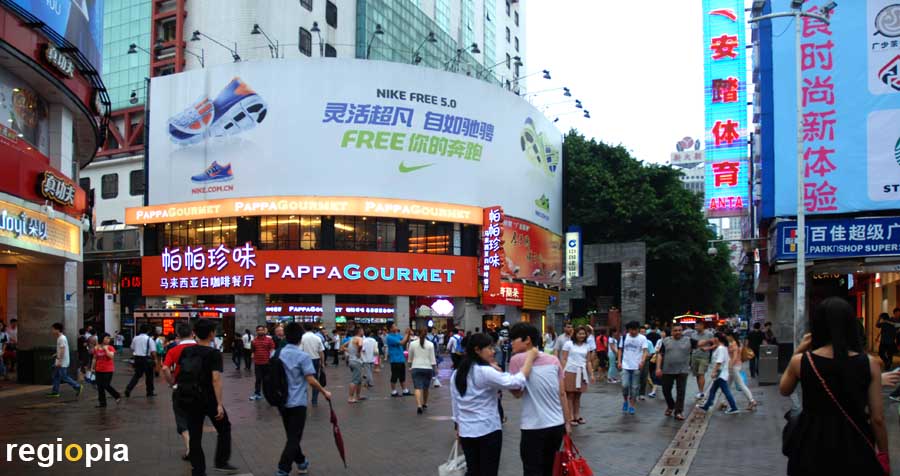
Beijing Lu 北京路
Beijing Rd is the main shopping street in Guangzhou. The intersection of Beijing Lu and Wanfu Lu is the center of the city. Large department stores, huge neon signs and crowds define the image of the pedestrian zone. The Beijing Lu runs south from the great east-west road Zhongshan Wu Lu to the Pearl River. In the middle of the pedestrian zone is an excavation site. The area around Beijing Lu is the place where the city of Guangzhou was emerged during the Qin Dynasty. At that time the city was called Panyu Cheng and was the capital of the Nanyue Kingdom. In the Nanyue King Museum you can visit the burial chamber where Nanyue King Zhao Mo was buried. The remains of walls and foundations that can be seen through the plexiglass panes in the floor, date from the Qin and Han dynasties. This part of Beijing Lu is also called the Millennium Ancient Road.
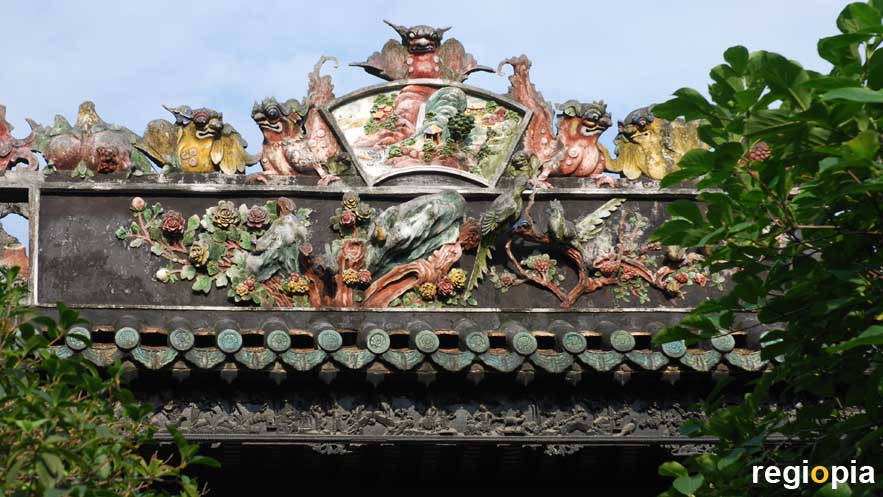
Chen Clan Academy 陈家祠
The Chen family academy Chen Shi Shuyuan is one of Guangzhou's most famous attractions. The Chen clan built the facility from 1890 as an ancestral temple and school for his family members. Only persons with the surname Chen had access at that time. The family academy of the Chens consists of many buildings connected by corridors. The corridors are slightly above the normal floor level and are covered to avoid getting wet. The roofs are ornately decorated with scenes from Chinese history, mythical creatures, plants, animals, immortals and scenes from traditional opera. The ancestral hall and the Chen family academy are now a museum that impresses with its traditional architecture.
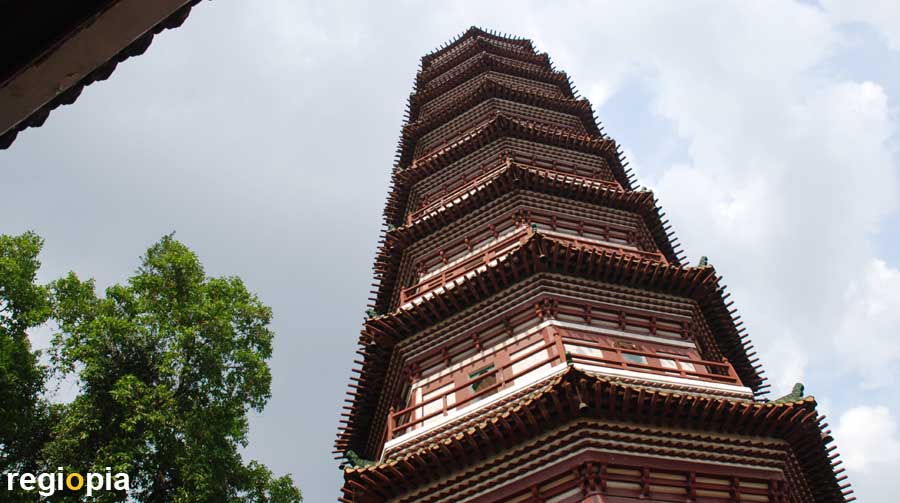
Temple of Six Banyan trees 六榕寺
The Temple of Six Banyan treesLiu Rong Si is one of the most important Buddhist sanctuaries of Guangzhou. The temple was built in 537 to house Ashes of Buddha. The 9-story Lotus Pagoda was built in 1097 in wood and stone. The pagoda is 57.6 m high and has 17 floors in the interior. At the top of the pagoda is a pillar carved with 1023 Buddha figures and 500 arhats. Therefore, it is also called the 1,000 Buddha Pagoda. It is a prime example of architecture south of the 5 Wuling mountain ranges. In the hall of Mahavira there are three Buddha statues each 6 m high which were cast in bronze in 1663. The hall itself was reconstructed in 1984. The Temple of the Six Banyan Trees is a bit hidden but once you have found the Liu Rong Lu, the Lotus Pagoda reveals the way.
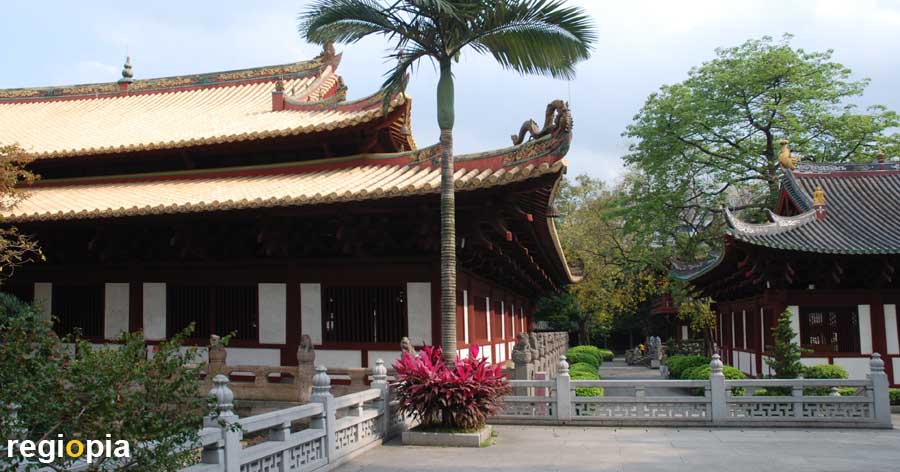
Guang Xiao Si 光孝寺
The temple complex of Guangxiao Si was built on the site where the palace of the Nan Yue King used to be (Nan Yue = Vietnam). The Temple of Glorious Infancy was built during the Han Dynasty (Han dynasty 206 BC to 6 AD). The Buddhist temple has seen many famous teachers. Especially the teachings of Chan Buddhism were spread from here throughout Asia. (Chan Buddhism is called Zen in Japan). During the Cultural Revolution 1966-1976 many buildings were destroyed. Most of the buildings of Guangxiao Temple were built in 1980 when the temple was rebuilt by Buddhist monks. However, the small stone pagodas are quite old, one was built in 676 AD.
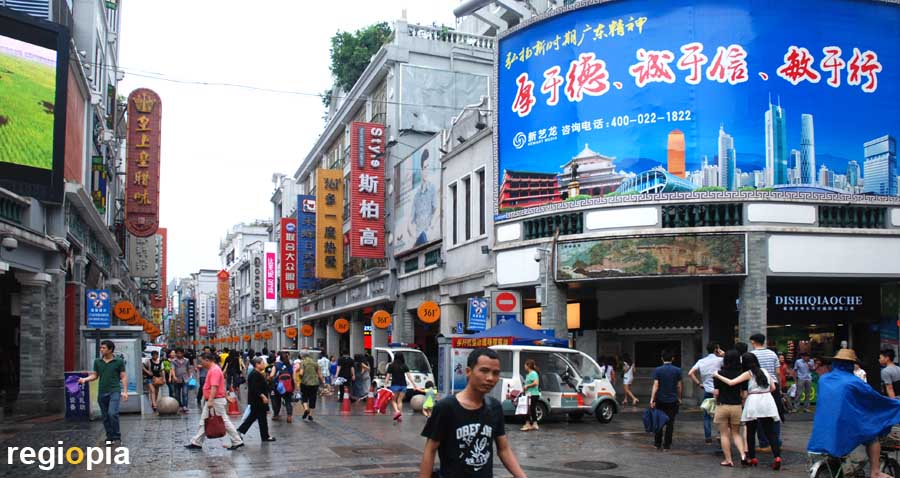
Dishifu Rd
Another well-known pedestrian street in Guangzhou is Dishifu Lu. This is a long east-waste street that meanders through the city centre. The street has many different names the name Dishifu and Shangjiajiu are the most famous. In Dishifu Lu you will find arcades and uniform facades made of masonry. However, these are not historical buildings but in the past these arcades were almost everywhere in Guangzhou. Arcades protected passers-by from the tropical rain or the burning sun. There are many restaurants where Dishifu Lu merges into Enning Lu. Here you can also find the famous Dim Sum or Xiao Long Bao, a specialty of Guangzhou.
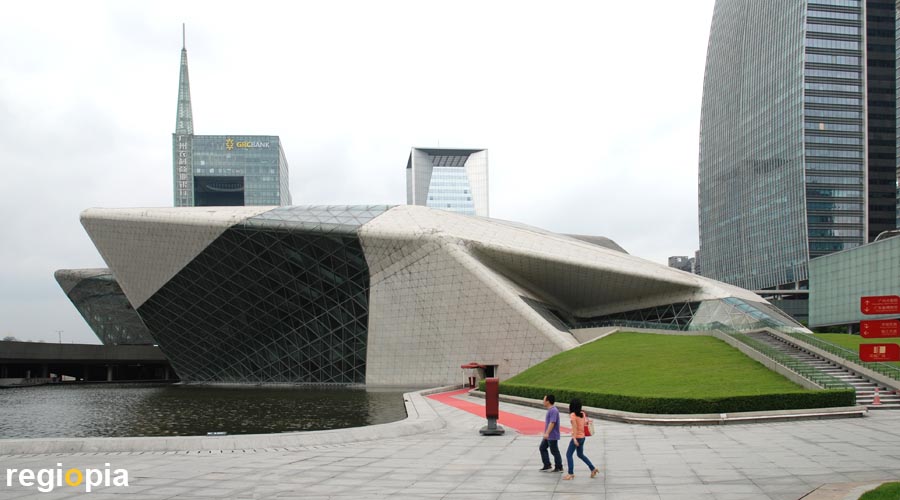
Opera Guangzhou 广州大剧院
The Guangzhou Opera House was designed by British architect Zaha Hadid and is an architectural landmark of the city. Zaha Hadid called her design "double pebble". The smooth shape symbolizes stones that were formed by the Pearl River. The opera is only a few meters away from the Pearl River. In front of the opera there is a water basin in which the building is reflected. The opera house is in the new Tianhe district, where one skyscraper after another is sprouting out of the damp ground. The Canton Tower is on the opposite side of the river. There is a subway station right at the opera.
1 Zhujiang W Rd, Tianhe District
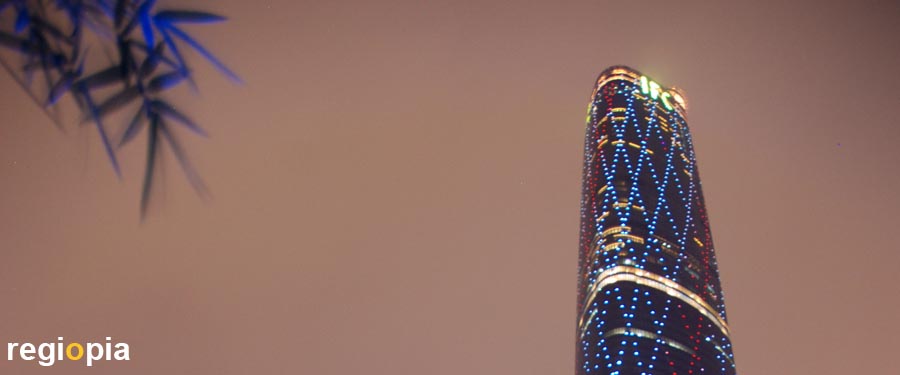
IFC Guangzhou
The International Finance Center in Guangzhou is a 438 m high skyscraper in the new financial district of Tianhe. IFC Guangzhou was designed by the London architects Wilkinson Eyre and opened in 2010. At that time, the IFC was the tallest skyscraper in Guangzhou. The tower has 103 floors of which the first 68 floors are used as office space, above which is the luxury hotel "Four Seasons". At the top of the tower there is a public viewing platform, called Skylobby. Since it is always warm and humid in Guangzhou, the view from high towers is rarely good during the day. It is best to arrive about an hour before sunset, then the lights go on and you have a spectacular view.
The Chow Tai Fook Center stands just opposite since 2016 at a height of 530 m. The angular CTF by New York architects Kohn Petersen Fox has been the tallest skyscraper in the city since. The IFC was the city's first tall skyscraper and has become a modern landmark of Guangzhou thanks to its elegant rounded shape that tapers slightly towards the top.
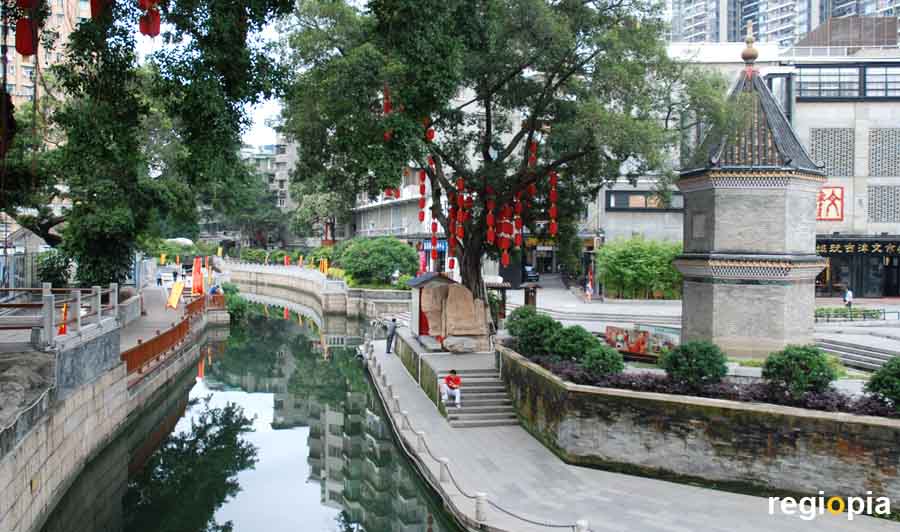
Liwan Hu Gong Yuan
Liwan Hu Gong Yuan is a park around the Liwan Lake (Pear Bay Lake). There are actually four small lakes that are connected by narrow headlands. There are restaurants and pedal boats, but you can also go for a walk on the bank. Liwan Hu is located in the far west of the city center and can easily reached by subway (Zhongshanba Station). On Longjin West Rd. There is a canal that runs along the park (photo). The area has been redeveloped and has become an elegant neighborhood on the water.
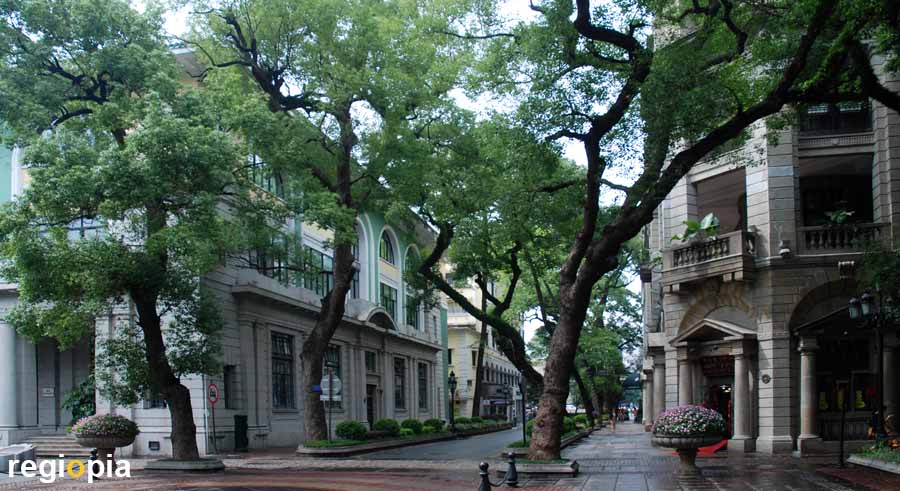
Shamian Dao 沙面
Shamian Dao (Sand Island) is a small island in the Pearl River that is connected to the city by bridges. Foreign traders were allowed to settle on this island from the 17th century onward. Europeans and Americans built trading posts here. That is why there are European buildings from around 1900 on the island. Urban development with wide streets and large trees also corresponds to the style in France and England of the time. These two countries were the first to get a concession to trade with China. Through the victories in the two Opium Wars, the British Empire gained to sell harmful drugs to China and got the island of Hong Kong. The other colonial powers setteled here later on.
After 1949 all buildings on the island were confiscated by PR of China. Nevertheless, the buildings are well preserved and the area looks very elegant. Shamian Dao is often used as a backdrop for wedding photos. There are cafes, restaurants, hotels and expensive shops. The promenade with a view over the Pearl River is the most beautiful part.
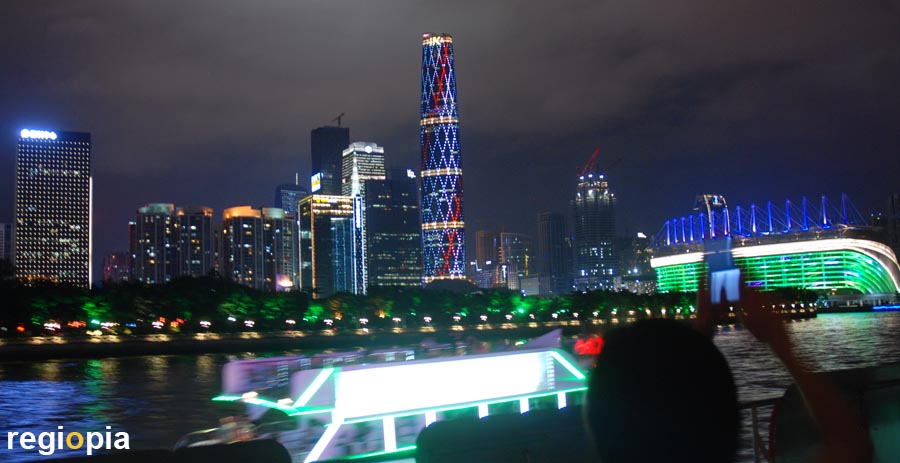
Night Cruise on the Pearl River
An evening boat trip on the Pearl River (Zhujiang in Chinese) is an experience. The whole city is brightly lit and you can't understand your own word on the ship because the music from the speakers drowns out everything. The skyscrapers try to outdo each other with an extravagant light show. Everything flashes and roars. In addition, many other brightly lit ships go up and down the river. The Chinese love it loud and lively. The departure and arrival piers are on Yanjiang West Road. The nights cruise is a highlight of Guangzhou.
Tourist Map Canton
ads
Travel Guide Guangzhou
Welcome to Guangzhou
Many people still know the city of Guangzhou under the name Canton, which was spread throughout Europe by the English. The British could not pronounce the name and did not even try, the result has little to do with the actual pronunciation. It is not that difficult, the name consists of the two characters that are pronounced something like "Guang Dshow".
ads


